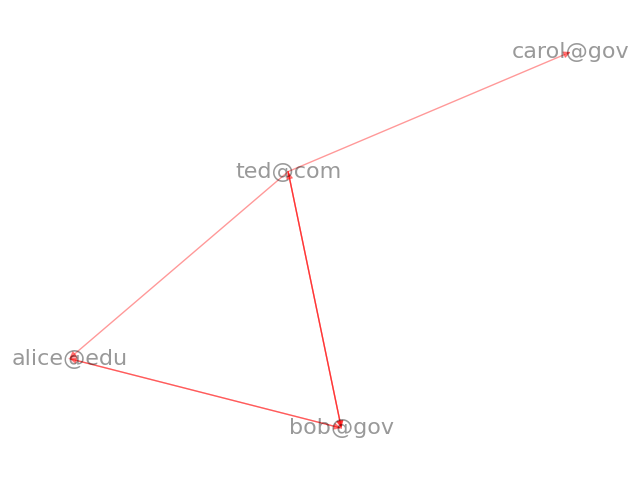Note
Go to the end to download the full example code.
Unix Email#
Create a directed graph, allowing multiple edges and self loops, from a unix mailbox. The nodes are email addresses with links that point from the sender to the receivers. The edge data is a Python email.Message object which contains all of the email message data.
This example shows the power of DiGraph to hold edge data of arbitrary Python
objects (in this case a list of email messages).
The sample unix email mailbox called “unix_email.mbox” may be found here:

From: alice@edu To: bob@gov Subject: NetworkX
From: bob@gov To: alice@edu Subject: Re: NetworkX
From: bob@gov To: ted@com Subject: Re: Graph package in Python?
From: ted@com To: bob@gov Subject: Graph package in Python?
From: ted@com To: bob@gov Subject: get together for lunch to discuss Networks?
From: ted@com To: carol@gov Subject: get together for lunch to discuss Networks?
From: ted@com To: alice@edu Subject: get together for lunch to discuss Networks?
from email.utils import getaddresses, parseaddr
import mailbox
import matplotlib.pyplot as plt
import networkx as nx
# unix mailbox recipe
# see https://docs.python.org/3/library/mailbox.html
def mbox_graph():
mbox = mailbox.mbox("unix_email.mbox") # parse unix mailbox
G = nx.MultiDiGraph() # create empty graph
# parse each messages and build graph
for msg in mbox: # msg is python email.Message.Message object
(source_name, source_addr) = parseaddr(msg["From"]) # sender
# get all recipients
# see https://docs.python.org/3/library/email.html
tos = msg.get_all("to", [])
ccs = msg.get_all("cc", [])
resent_tos = msg.get_all("resent-to", [])
resent_ccs = msg.get_all("resent-cc", [])
all_recipients = getaddresses(tos + ccs + resent_tos + resent_ccs)
# now add the edges for this mail message
for target_name, target_addr in all_recipients:
G.add_edge(source_addr, target_addr, message=msg)
return G
G = mbox_graph()
# print edges with message subject
for u, v, d in G.edges(data=True):
print(f"From: {u} To: {v} Subject: {d['message']['Subject']}")
pos = nx.spring_layout(G, iterations=10, seed=227)
nx.draw(G, pos, node_size=0, alpha=0.4, edge_color="r", font_size=16, with_labels=True)
ax = plt.gca()
ax.margins(0.08)
plt.show()
Total running time of the script: (0 minutes 0.130 seconds)